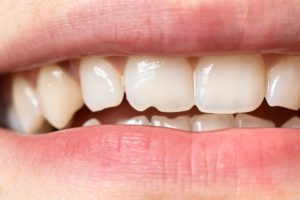Dental bonding is a type of cosmetic treatment made of composite resin. Often, dentists utilize dental bonding because it is the color of your teeth. This means that the treatment blends with the rest of your tooth, making it almost invisible. Due to its flexible nature, dentists use dental bonding to fix many dental issues—both cosmetic and restorative. One restorative use helps fix tooth decay.
When you have a cavity, your dentist will drill out the decayed portion of your tooth and fill the cavity with a composite resin. This is the same material and procedure as dental bonding. Additionally, you can choose dental bonding for many cosmetic issues. Some of these issues include chipped or broken teeth, discoloration issues, or awkwardly shaped teeth.

Teeth Whitening
Having white teeth is a desire of many patients. Fortunately, most patients can use at-home whitening treatments or a professional whitening treatment from the dentist. Chemical treatments use hydrogen peroxide and other bleaching chemicals to break down the stain. However, these treatments cannot fix all color issues.
Dental trauma can cause stains deep within the tooth that cannot be altered chemically. Additionally, some patients can inherit genetic problems that affect their teeth. Also, medications can create difficult stains. For example, taking certain antibiotics before the age of 12 can damage the enamel on permanent teeth.
Therefore, your dentist must camouflage the stains rather than get rid of them. This is where dental bonding comes in handy. The tooth-colored resin will hide any significant stains.
Chipped or Broken Teeth
Your enamel is very strong. In fact, it is the strongest tissue in your body. However, the enamel is not indestructible. It is capable of chipping and breaking due to certain foods or pressures. When enamel chips or breaks, it is not just a cosmetic issue.
The enamel is the protective outer covering of your teeth. It keeps harmful bacteria from damaging the delicate insides. Damaged enamel cannot keep bacteria out of your teeth. Unfortunately, this can create dental issues. For example, cavities occur when bacteria destroy the enamel and decay the inner pulp and nerves. Without treatment, cavities can cause infections and tooth loss.
Dental bonding can help avoid further decay and wear.
Small or Misshapen Teeth
Dental bonding can also alter the actual shape of your teeth. If you have smaller teeth or teeth that are misshapen, your dentist can use dental bonding to create a new tooth shape. Dental bonding is useful for many reasons. However, it is not durable for teeth that experience high impact.
For example, dental bonding may not be great for creating ridges on back molars. These teeth grind food, making it difficult to support dental bonding. Instead, dentists may use dental bonding on your front teeth to create a longer, more attractive tooth.
